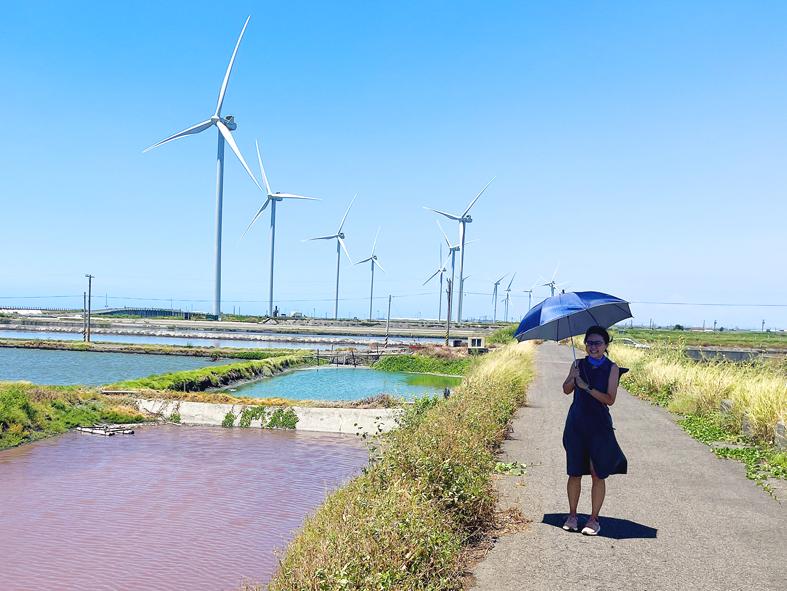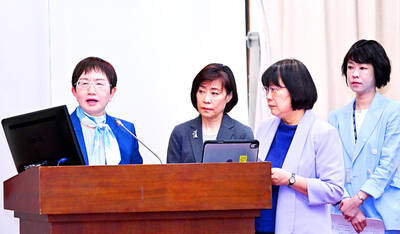The Ministry of Economic Affairs on Friday said it expects the nation to obtain 15.1 percent of its electricity from renewable sources by 2025, falling short of a 20 percent target set by President Tsai Ing-wen (蔡英文) in 2016.
The Taiwan Energy Statistics Year Book report, published on Friday by the Bureau of Energy, said that the share of renewables in the nation’s electricity mix had increased to 6 percent by the end of last year and is expected to reach 8 percent by the end of this year.
After taking office in 2016 — when renewables accounted for 4.1 percent of Taiwan’s electricity mix — Tsai laid out plans to obtain 20 percent of the nation’s electricity from renewables by 2025, with 50 percent coming from natural gas and 30 percent from coal.

Photo: CNA
The plan was part of a campaign promise to phase out the country’s three remaining nuclear power plants, which provided about 9.6 percent of Taiwan’s electricity last year.
The report blamed the target shortfall on increasing demand for electricity.
Electricity consumption last year rose 4.5 percent from a year earlier, driven by increased production in the manufacturing sector after the global economy rebounded from the COVID-19 pandemic, the report said.
Meanwhile, integrating renewable energy sources into the grid in a way that allows them to operate at full capacity remains a challenge, with grid connections for renewable sources not expected to be completed until the end of 2025, it said.
The government is now hoping to realize Tsai’s 20 percent target by October 2026, it added.
By utilizing power generation from offshore wind farms, solar projects and biofuel energy, the government aims to increase the share of renewables to 21 percent in 2027 and 23 percent in 2028, the report said.
As of the end of last year, the nation’s total solar installation only reached 7.7 gigawatt (GW), missing the government’s target of 8.75GW, energy bureau data showed.
It was the third consecutive year Taiwan failed to meet its solar installation goal.
The 2020 target was 6.5GW, but only 5.82GW was operational at the end of that year, the data showed.
To achieve the government’s 2025 target of 20GW from solar installations, it must annually add a capacity of 3GW from this year.
However, the nation’s newly added capacity was 680 megawatt in the first five months of the year, reaching only 22.7 percent of the year’s target, with accumulated installation of 8.38GW far below the government’s expectations.
Companies in the solar industry attributed the slower-than-expected adoption to soaring raw material prices, logistics bottlenecks caused by COVID-19 lockdowns in China, worldwide port congestion and surging freight rates.
The bureau said it had launched several measures to encourage solar installation, including on June 28, announcing it would maintain its solar feed-in tariffs for the second half of the year, citing rising installation costs.
It also started requiring rooftop solar system installation on suitable buildings, regardless of whether they are newly built, extensions or reconstructions, it added.
Additional reporting by Chen Cheng-hui

‘SWASTICAR’: Tesla CEO Elon Musk’s close association with Donald Trump has prompted opponents to brand him a ‘Nazi’ and resulted in a dramatic drop in sales Demonstrators descended on Tesla Inc dealerships across the US, and in Europe and Canada on Saturday to protest company chief Elon Musk, who has amassed extraordinary power as a top adviser to US President Donald Trump. Waving signs with messages such as “Musk is stealing our money” and “Reclaim our country,” the protests largely took place peacefully following fiery episodes of vandalism on Tesla vehicles, dealerships and other facilities in recent weeks that US officials have denounced as terrorism. Hundreds rallied on Saturday outside the Tesla dealership in Manhattan. Some blasted Musk, the world’s richest man, while others demanded the shuttering of his

ADVERSARIES: The new list includes 11 entities in China and one in Taiwan, which is a local branch of Chinese cloud computing firm Inspur Group The US added dozens of entities to a trade blacklist on Tuesday, the US Department of Commerce said, in part to disrupt Beijing’s artificial intelligence (AI) and advanced computing capabilities. The action affects 80 entities from countries including China, the United Arab Emirates and Iran, with the commerce department citing their “activities contrary to US national security and foreign policy.” Those added to the “entity list” are restricted from obtaining US items and technologies without government authorization. “We will not allow adversaries to exploit American technology to bolster their own militaries and threaten American lives,” US Secretary of Commerce Howard Lutnick said. The entities

Minister of Finance Chuang Tsui-yun (莊翠雲) yesterday told lawmakers that she “would not speculate,” but a “response plan” has been prepared in case Taiwan is targeted by US President Donald Trump’s reciprocal tariffs, which are to be announced on Wednesday next week. The Trump administration, including US Secretary of the Treasury Scott Bessent, has said that much of the proposed reciprocal tariffs would focus on the 15 countries that have the highest trade surpluses with the US. Bessent has referred to those countries as the “dirty 15,” but has not named them. Last year, Taiwan’s US$73.9 billion trade surplus with the US

Prices of gasoline and diesel products at domestic gas stations are to fall NT$0.2 and NT$0.1 per liter respectively this week, even though international crude oil prices rose last week, CPC Corp, Taiwan (台灣中油) and Formosa Petrochemical Corp (台塑石化) said yesterday. International crude oil prices continued rising last week, as the US Energy Information Administration reported a larger-than-expected drop in US commercial crude oil inventories, CPC said in a statement. Based on the company’s floating oil price formula, the cost of crude oil rose 2.38 percent last week from a week earlier, it said. News that US President Donald Trump plans a “secondary